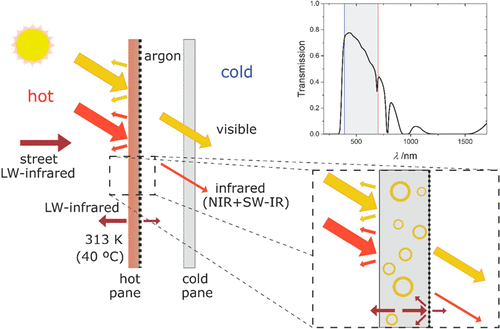当前位置:
X-MOL 学术
›
Nano Lett.
›
论文详情
Our official English website, www.x-mol.net, welcomes your
feedback! (Note: you will need to create a separate account there.)
Plasmonic Glasses and Films Based on Alternative Inexpensive Materials for Blocking Infrared Radiation
Nano Letters ( IF 9.6 ) Pub Date : 2018-04-05 00:00:00 , DOI: 10.1021/acs.nanolett.8b00764 Lucas V. Besteiro 1, 2 , Xiang-Tian Kong 1, 3 , Zhiming Wang 1 , Federico Rosei 2 , Alexander O. Govorov 3
Nano Letters ( IF 9.6 ) Pub Date : 2018-04-05 00:00:00 , DOI: 10.1021/acs.nanolett.8b00764 Lucas V. Besteiro 1, 2 , Xiang-Tian Kong 1, 3 , Zhiming Wang 1 , Federico Rosei 2 , Alexander O. Govorov 3
Affiliation

|
The need for energy-saving materials is pressing. This Letter reports on the design of energy-saving glasses and films based on plasmonic nanocrystals that efficiently block infrared radiation. Designing such plasmonic composite glasses is nontrivial and requires taking full advantage of both material and geometrical properties of the nanoparticles. We compute the performance of solar plasmonic glasses incorporating a transparent matrix and specially shaped nanocrystals. This performance depends on the shape and material of such nanocrystals. Glasses designed with plasmonic nanoshells are shown to exhibit overall better performances as compared to nanorods and nanocups. Simultaneously, scalable synthesis of plasmonic nanoshells and nanocups is technologically feasible using gas-phase fabrication methods. The computational simulations were performed for noble metals (gold and silver) as well as for alternative plasmonic materials (aluminum, copper, and titanium nitride). Inexpensive plasmonic materials (silver, copper, aluminum, and titanium nitride) show an overall good performance in terms of the commonly used figures of merit of industrial glass windows. Together with numerical data for specific materials, this study includes a set of general rules for designing efficient plasmonic IR-blocking media. The plasmonic glasses proposed herein are good candidates for the creation of cheap optical media, to be used in energy-saving windows in warm climates’ housing or temperature-sensitive infrastructure.
中文翻译:

基于替代廉价材料的等离子玻璃和薄膜可阻挡红外辐射
迫切需要节能材料。这封信报道了基于等离子纳米晶体的高效节能玻璃和薄膜的设计,该薄膜可有效阻挡红外辐射。设计这种等离激元复合玻璃并非易事,需要充分利用纳米颗粒的材料和几何特性。我们计算结合了透明基质和特殊形状的纳米晶体的太阳能等离子玻璃的性能。该性能取决于这种纳米晶体的形状和材料。与等离子纳米棒和纳米杯相比,用等离激元纳米壳设计的玻璃表现出总体上更好的性能。同时,使用气相制备方法,等离子纳米壳和纳米杯的可扩展合成在技术上是可行的。对贵金属(金和银)以及其他等离子体材料(铝,铜和氮化钛)进行了计算仿真。廉价的等离激元材料(银,铜,铝和氮化钛)根据常用的工业玻璃窗品质因数显示出总体良好的性能。连同特定材料的数值数据,本研究包括了一套用于设计有效的等离激元红外阻隔介质的一般规则。本文提出的等离子玻璃是创建廉价光学介质的良好候选者,该介质可用于温暖气候的房屋或对温度敏感的基础设施中的节能窗户中。廉价的等离激元材料(银,铜,铝和氮化钛)根据常用的工业玻璃窗品质因数显示出总体良好的性能。连同特定材料的数值数据,本研究包括了一套用于设计有效的等离激元红外阻隔介质的一般规则。本文提出的等离子玻璃是创建廉价光学介质的良好候选者,该介质可用于温暖气候的房屋或对温度敏感的基础设施中的节能窗户中。廉价的等离激元材料(银,铜,铝和氮化钛)根据常用的工业玻璃窗品质因数显示出总体良好的性能。连同特定材料的数值数据,本研究包括了一套用于设计有效的等离激元红外阻隔介质的一般规则。本文提出的等离子玻璃是创建廉价光学介质的良好候选者,该介质可用于温暖气候的房屋或对温度敏感的基础设施中的节能窗户中。
更新日期:2018-04-05
中文翻译:

基于替代廉价材料的等离子玻璃和薄膜可阻挡红外辐射
迫切需要节能材料。这封信报道了基于等离子纳米晶体的高效节能玻璃和薄膜的设计,该薄膜可有效阻挡红外辐射。设计这种等离激元复合玻璃并非易事,需要充分利用纳米颗粒的材料和几何特性。我们计算结合了透明基质和特殊形状的纳米晶体的太阳能等离子玻璃的性能。该性能取决于这种纳米晶体的形状和材料。与等离子纳米棒和纳米杯相比,用等离激元纳米壳设计的玻璃表现出总体上更好的性能。同时,使用气相制备方法,等离子纳米壳和纳米杯的可扩展合成在技术上是可行的。对贵金属(金和银)以及其他等离子体材料(铝,铜和氮化钛)进行了计算仿真。廉价的等离激元材料(银,铜,铝和氮化钛)根据常用的工业玻璃窗品质因数显示出总体良好的性能。连同特定材料的数值数据,本研究包括了一套用于设计有效的等离激元红外阻隔介质的一般规则。本文提出的等离子玻璃是创建廉价光学介质的良好候选者,该介质可用于温暖气候的房屋或对温度敏感的基础设施中的节能窗户中。廉价的等离激元材料(银,铜,铝和氮化钛)根据常用的工业玻璃窗品质因数显示出总体良好的性能。连同特定材料的数值数据,本研究包括了一套用于设计有效的等离激元红外阻隔介质的一般规则。本文提出的等离子玻璃是创建廉价光学介质的良好候选者,该介质可用于温暖气候的房屋或对温度敏感的基础设施中的节能窗户中。廉价的等离激元材料(银,铜,铝和氮化钛)根据常用的工业玻璃窗品质因数显示出总体良好的性能。连同特定材料的数值数据,本研究包括了一套用于设计有效的等离激元红外阻隔介质的一般规则。本文提出的等离子玻璃是创建廉价光学介质的良好候选者,该介质可用于温暖气候的房屋或对温度敏感的基础设施中的节能窗户中。











































 京公网安备 11010802027423号
京公网安备 11010802027423号